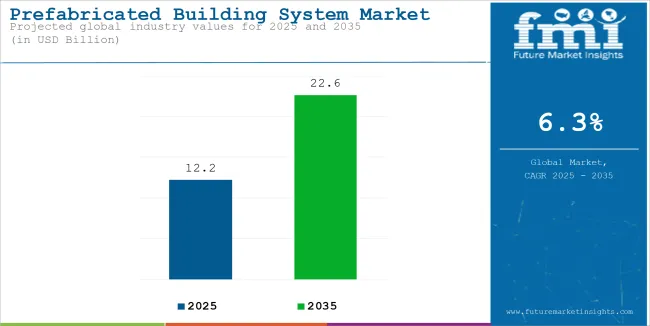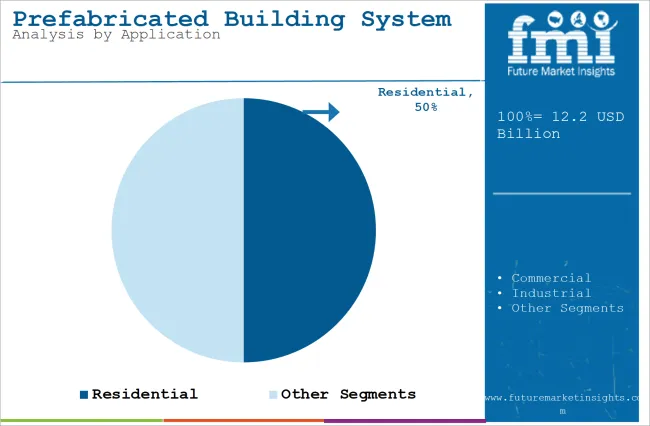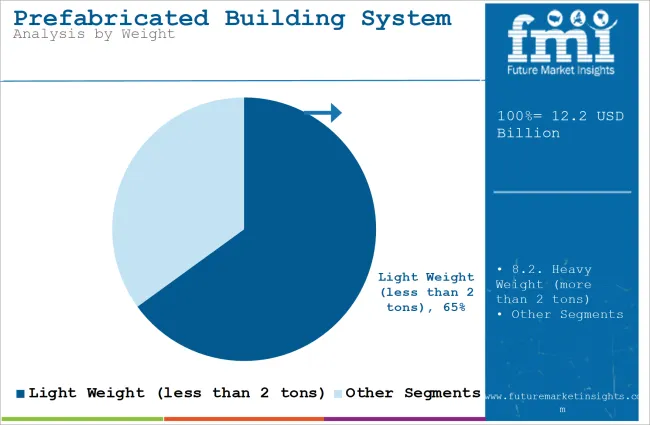The global prefabricated building system market is estimated to account for USD 12.22 billion in 2025. It is anticipated to grow at a CAGR of 6.3% during the assessment period and reach a value of USD 22.64 billion by 2035.

| Attributes | Description |
|---|---|
| Estimated Global Prefabricated Building Systems Market Size (2025E) | USD 12.22 billion |
| Projected Global Prefabricated Building Systems Market Value (2035F) | USD 22.64 billion |
| Value-based CAGR (2025 to 2035) | 6.3% |
Residential Sector to Bring the Most Revenue

| Attributes | Details |
|---|---|
| By Application | Residential |
| Market Share in 2025 | 50% |
By application, the market is segmented into residential, commercial, and industrial. The residential sector is the leading application segment with an anticipated revenue share of 50% in 2025.
The rising popularity of prefabricated building systems in residential construction stems from their efficient installation timelines and cost-effectiveness while maintaining design flexibility and sustainability standards. The panel's versatility makes them particularly suitable for diverse applications, from residential developments to commercial spaces.
Their modular nature enables efficient transportation and assembly, even in remote locations. This adaptability has proven valuable across multiple sectors, including apartment complexes to single-family residences.
Ease of Transport of Light Weight (Less Than 2 Tons) Products to Surge Sales

| Attributes | Details |
|---|---|
| By Weight | Lightweight (Less than 2 Tons) |
| Market Share in 2025 | 65% |
In terms of weight, the market is segregated into light weight (less than 2 tons) and heavy weight (more than 2 tons). The light weight (less than 2 tons) is the leading segment with an anticipated revenue share of 65% in 2025.
The ease of transport and installation of these systems make them widely used. Additionally, they do not need massive foundations like traditional buildings do. Due to growing number of cities, developers are increasingly shifting toward these lightweight solutions.
These solutions are proving ideal for both homes and commercial projects, offering quick assembly while maintaining high standards. Additionally, owing to new material technologies nowadays, they have become more durable and environmentally friendly than ever before.
Technological Advancements in Skeleton Systems to Augment their Demand
In terms of dimension, the market is divided into skeleton system, panel system, cellular system, and combined system. Technological innovations in skeleton systems are boosting their adoption. Now, these systems are being equipped with robotic fabrication to enhance the efficiency and precision in the construction process. Additionally, 3D printing technology is being deployed for complex structures.
A prefabricated building system entails the establishment of buildings with parts such as roofs, walls, and others in a factory or outside setting. After the construction, they are moved to the actual construction site. It employs lightweight high-strength concrete, digital design and manufacturing, smart integration, and modular innovations to create energy-efficient buildings.
Moreover, lightweight high-strength concrete (LWHSC) combines high strength and low weight, making it ideal for high-rise buildings, long-span bridges, and offshore structures. It provides strength, energy efficiency, and resistance to deformation, making it a great renewable alternative to steel.
Plus, with the rise of 3D printing, components with smart features can be created using concrete and polymers. Additionally, these materials can self-heal and help regulate temperature through built-in sensors. Notable examples of this innovation include ultra-high-performance concrete (UHPC) and cross-laminated timber (CLT), both of which are paving the way for smarter, more sustainable building practices.
Furthermore, digital design and manufacturing bring creativity to life through the usage of tools such as building information modeling (BIM) to create detailed 3D models. This approach makes it much easier to bring ideas to life while minimizing errors.
With designs that can be tailored using algorithms, robots handle tasks such as cutting and putting together parts. On top of that, digital twins give us real-time insights, allowing us to track and improve the building process, making everything run more smoothly.
Modular innovations revolutionize construction with methods such as volumetric modular construction, where fully finished room modules are made in factories and then transported to the site for easy assembly, similar to Lego blocks.
This approach is perfect for building hospital rooms, classrooms, or homes. Hybrid modular systems mix these modules with panelized components for added flexibility, while flat-pack systems allow parts to collapse for transport and expand on-site, saving on shipping costs.
Due to growing sustainability and energy efficiency, companies are striving for net-zero prefabrication, where buildings generate as much energy as they use. This is done using smart designs, great insulation, and solar panels.
Additionally, circular construction encourages reusing modular parts to reduce waste. Plus, green roofs and walls boost insulation and air quality, while energy-generating facades harness solar power for a cleaner future.
Smart Integration is changing construction with pre-installed IoT devices that enhance safety, efficiency, and sustainability. Prefabricated components come with sensors to monitor energy use and environmental conditions.
Smart home systems include automation for lighting, heating, and security, making life easier. Additionally, panels with built-in HVAC systems ensure efficient climate control, creating comfortable and connected living spaces.
Other advanced materials include 3D printing on-site, automated transport scheduling, disaster-resilient modules, AI-driven cost optimization, façade customization, and others.
Growing Urbanization to Foster Product Sales
Urbanization and rising housing demand are driving the growth of prefabricated buildings . As more people move to cities, the demand for quick and affordable housing is rising. Traditional building methods cannot keep up, making prefabrication an attractive option.
With the UN predicting that 70% of the global population will be urban by 2050, more and more countries are focusing on pragmatic solutions that meet the urban needs. For instance, initiatives such as India’s Pradhan Mantri Awas Yojana (PMAY) are delivering millions of homes, demonstrating how prefabrication can efficiently meet the needs of growing urban populations.
Cost Reduction and Resource Efficiency Key Selling Points of Prefabricated Buildings
Prefab construction is revolutionizing the building & construction industry. By making parts in factories instead of on-site, huge benefits in both time and money are being witnessed. It is helping the industry cope with worker shortages, especially in the USA and Europe.
Additionally, now workers in factories can recycle materials, making the whole process greener. Labor costs have also dropped by a quarter, which is a game-changer in today's economy.
Rising Sustainability and Environmental Concerns to Shift Toward Prefabrication
While traditional building use a lot of carbon, prefab construction is helping build cleaner buildings. Making parts in factories not only uses less energy but also creates less waste since materials can be recycled. Moreover, Sweden's Sara Cultural Centre uses prefab timber, which is completely carbon neutral.
This route is being chosen by more and more builders due to rising environmental consciousness. Thus, urbanization, housing demand, cost efficiency, and sustainability are driving prefabrication growth. This approach addresses population growth and affordable housing, providing a practical solution for modern construction.
High Upfront Cost May Pose a Barrier
While prefab construction offers many benefits, it presents challenges to manufacturers. Setting up manufacturing facilities incurs high upfront costs, which can be tough for smaller companies to manage. Additionally, a standardized approach sometimes limits creativity, making it harder to attract high-end projects.
Furthermore, moving big building pieces also adds to the overall cost, especially in busy city centers. Finding workers who know how to handle these specialized systems is another challenge, and training them takes time and money.
Technological Innovations in Prefabricated Buildings Systems
Industries across the world are updating their construction technique with the adoption of the growing trends in advanced modular construction, innovation in designs, sustainable materials, and digital technologies. This factor is leading to quicker build times, cost efficiency, and more flexibility.
Nowadays, skeleton systems are being built to be strong yet adaptable. They use innovative materials such as engineered timber and smart technology that keep an eye on the structure’s health. This flexibility allows for spacious layouts, perfect for high-rise buildings.
Building information modeling (BIM) and blockchain technology are also making planning smoother and more transparent, which helps build trust among everyone involved. Additionally, smart factories and AI tools are boosting productivity by automating repetitive tasks and reducing waste.
| Countries | CAGR |
|---|---|
| USA | 5.2% |
| India | 6.6% |
| China | 4.8% |
China
China leads the world in prefabricated building systems, and is likely to hold a 21% market share in 2025, owing to initiatives by the government for promoting industrialized construction. The country excels in skeleton and cellular systems, benefiting from large-scale manufacturing.
Companies such as Broad Group dominate and have completed many high-rise modular projects, such as 57-story buildings, in minimal time. However, the environmental impact of resource-heavy manufacturing processes presents significant challenges for sustainable development.
India
The growing popularity of prefabricated construction, specifically in infrastructure projects such as airports, railways, and others is proliferating market growth in the country. Additionally, the deployment of hybrid prefabrication methods by giants such as Tata Steel and Larsen & Toubro to fulfill varied regional needs is further boosting market expansion.
South Korea
South Korea is quickly adopting cellular and panel systems to meet urban needs. Modular construction is common in Seoul, backed by government support. However, limited factory space and high logistics costs pose challenges.
Japan
Japan has a mature prefabricated market, focusing on earthquake-resistant designs. Companies such as Sekisui House are well-regarded, but high production costs and strict building codes limit exports.
The USA prefabricated building system market is poised to showcase a CAGR of 5.2% during the study period, driven by rising demand for modular construction across residential, commercial, and infrastructure sectors. Affordable housing projects are increasingly utilizing cellular systems due to urbanization and high construction costs.
Additionally, panel systems are being favored for their energy efficiency, and for meeting strict building codes. Companies such as Clayton Homes and Skanska USA are embracing advanced technologies to boost efficiency. As awareness of construction waste grows and government initiatives promote green buildings, the market is set to expand further.
United Kingdom
In the UK, prefabrication is on the rise as the government pushes for affordable housing. Additionally, skeleton and combined systems are popular for urban high-rises. Companies such as Laing O’Rourke are also using automation, but labor shortages and Brexit-related issues are causing delays and higher costs.
Germany
Germany excels in energy-efficient construction, with prefabricated homes making up about 20% of new residential buildings. Companies such as SchwörerHaus are integrating smart panels equipped with embedded technologies. However, high costs and a lack of skilled labor hold back smaller developers from investing in these technologies.
The prefabricated building system market has a highly competitive structure and players are adopting various strategies to achieve a competitive advantage. Companies including Karmod Prefabricated Building Technologies and Red Sea Housing emphasize government contracts for industrial accommodations and disaster relief.
On the other hand, Volumetric Building Companies (VBC) and Timber Building Systems are heavily investing in advanced technologies such as IoT-based modules and BIM.
Furthermore, sustainability has also become a prominent trend in the market with companies such as Timber Building Systems and TSSC Harwal Group deploying renewable and energy-efficient materials into their processes. Despite this, upheavals in supply chains, growing raw material costs, and stringent regulations are presenting barriers for small firms.
| Company | Area of focus |
|---|---|
| Karmod Prefabricated Building Technologies | Use of environmentally friendly materials and processes to reduce carbon footprints and enhance sustainability. |
| Volumetric Building Companies | Delivering large-scale, prefabricated modular buildings using volumetric construction techniques. |
| Red Sea Housing | Construction of low- and mid-rise apartments, offices, hotels and high security buildings. |
| Bajaj Steel Industries Ltd. | Pre-engineered steel buildings and industrial civil buildings, engineering and construction services. |
| Startup | Description |
|---|---|
| Mighty Buildings | A USA-based startup that utilizes 3D printing technology to create prefabricated structures using non-silicate light stone material (LSM) and steel components. Their approach aims to reduce waste and enhance efficiency in construction. |
| Modulous | A UK-based company offering a "Kit of Parts" for modular construction, enabling rapid assembly of residential buildings. Their system promotes local employment and environmental sustainability by shipping high-quality components to trained assemblers near the project site. |
| Katerra | A USA startup that streamlines the design-build process by leveraging building information modeling (BIM) software and modular construction techniques. Katerra is involved throughout the entire building process, from concept design to the finished product, aiming to eliminate costs across the construction value chain. |
| Blu Homes | Based in California, Blu Homes provides luxury prefabricated homes with a focus on energy efficiency and customization. Their homes are designed to be 40% more energy efficient than standard new homes, incorporating features like advanced thermal insulation and eco-friendly water fixtures. |
| Project Frog | A San Francisco-based company producing prefabricated building components with configurable kits of parts designed for flat-packed shipping. Initially focusing on the educational market, Project Frog aims to deliver high-quality, energy-efficient buildings. |
| ReMo Homes | A USA startup creating sustainable, zero-carbon modular homes to address housing affordability and climate change challenges. They utilize advanced manufacturing in factory settings to enhance construction efficiency, significantly reducing time and cost compared to traditional methods. |
| Offsite Modular | Specializes in developing modular living spaces, focusing on off-site construction methods to improve efficiency and reduce environmental impact. Their approach allows for rapid assembly and scalability in modern housing demands. |
| Flexobuild | A company offering prefabricated homes with an emphasis on flexibility and customization. Their designs aim to provide affordable housing solutions through efficient modular construction techniques. |
| Type Five | Develops modular design software to streamline the architectural design process for modular buildings. Their tools assist in creating efficient, scalable designs suitable for prefabrication. |
| Igloo Villa | A startup specializing in prefabricated dome homes, offering unique and sustainable housing options. Their designs focus on energy efficiency and rapid assembly, catering to diverse living needs. |
In terms of application, the prefabricated building system market is segregated into commercial, industrial, and residential.
By weight, the market is divided into heavy weight (more than 2 tons) and light weight (less than 2 tons).
In terms of dimension, the market is classified into panel system, cellular system, combined system, and skeleton system.
The market is estimated at USD 12.22 Billion in 2025.
The biggest trend in prefabricated building systems is the integration of sustainable materials and advanced automation technologies, including 3D printing and modular construction, to enhance efficiency and reduce environmental impact.
The top five cities for prefabricated building system startups are San Francisco, Bangalore, Berlin, Singapore, and Dubai.
A market research report on prefabricated building systems covers market dynamics, segmentation, key players, technological trends, regional insights, and future forecasts to provide a comprehensive industry analysis.






Full Research Suite comprises of:
Market outlook & trends analysis
Interviews & case studies
Strategic recommendations
Vendor profiles & capabilities analysis
5-year forecasts
8 regions and 60+ country-level data splits
Market segment data splits
12 months of continuous data updates
DELIVERED AS:
PDF EXCEL ONLINE
Prefabricated Composite Sandwich Panels Market Size and Share Forecast Outlook 2025 to 2035
Prefabricated Bathroom Pods Market Size and Share Forecast Outlook 2025 to 2035
Modular & Prefabricated Construction Market Size and Share Forecast Outlook 2025 to 2035
Building Information Modeling Market Size and Share Forecast Outlook 2025 to 2035
Building Envelope Market Size and Share Forecast Outlook 2025 to 2035
Building Access Control Security Market Size and Share Forecast Outlook 2025 to 2035
Building Materials Market Size and Share Forecast Outlook 2025 to 2035
Building Maintenance Unit (BMU) Market Size and Share Forecast Outlook 2025 to 2035
Building Energy Management Solutions Market Size and Share Forecast Outlook 2025 to 2035
Building Thermal Insulation Market Growth - Trends & Forecast 2025 to 2035
Building Integrated Photovoltaics Market - Solar & Architecture
Building Information Management (BIM) Market Analysis – Trends & Forecast 2024-2034
Building Automation System Market Size and Share Forecast Outlook 2025 to 2035
Building Automation System Industry Analysis in Korea Analysis - Size, Share, and Forecast Outlook 2025 to 2035
Leading Providers & Market Share in Building Automation System
In-building Wireless Market Insights – Trends & Forecast 2024-2034
Smart Building Delivery Robot Market Size and Share Forecast Outlook 2025 to 2035
Smart Building Solutions Market Size and Share Forecast Outlook 2025 to 2035
Smart Building Market Size and Share Forecast Outlook 2025 to 2035
Green Building Materials Market Analysis by Type, Application, End-user and Region: Forecast for 2025 and 2035

Thank you!
You will receive an email from our Business Development Manager. Please be sure to check your SPAM/JUNK folder too.
Chat With
MaRIA